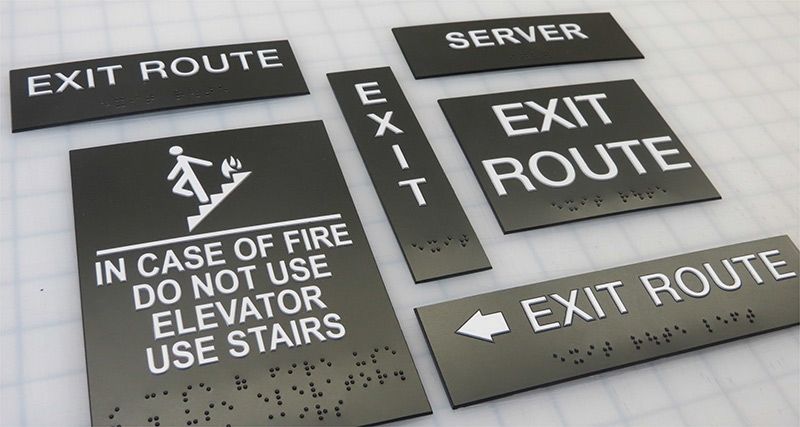Checking Out Imaginative Styles for Effective ADA Signs
Checking Out Imaginative Styles for Effective ADA Signs
Blog Article
Discovering the Key Features of ADA Indications for Boosted Ease Of Access
In the world of access, ADA signs serve as quiet yet effective allies, guaranteeing that areas are accessible and comprehensive for individuals with specials needs. By integrating Braille and responsive elements, these indicators break obstacles for the aesthetically impaired, while high-contrast shade plans and readable fonts provide to varied aesthetic demands.
Relevance of ADA Compliance
Guaranteeing compliance with the Americans with Disabilities Act (ADA) is crucial for promoting inclusivity and equal accessibility in public areas and workplaces. The ADA, passed in 1990, mandates that all public facilities, employers, and transportation services accommodate people with impairments, guaranteeing they delight in the exact same legal rights and possibilities as others. Conformity with ADA requirements not just satisfies legal obligations but also improves a company's credibility by showing its dedication to diversity and inclusivity.
One of the essential aspects of ADA conformity is the application of accessible signage. ADA indicators are developed to make certain that people with disabilities can quickly browse with spaces and structures.
Furthermore, adhering to ADA regulations can minimize the risk of lawful consequences and possible penalties. Organizations that stop working to abide by ADA standards may deal with legal actions or fines, which can be both financially difficult and harmful to their public photo. Therefore, ADA conformity is essential to promoting an equitable setting for everybody.
Braille and Tactile Components
The unification of Braille and tactile aspects right into ADA signs embodies the concepts of access and inclusivity. It is generally placed underneath the equivalent message on signage to ensure that people can access the info without visual help.
Tactile elements extend beyond Braille and include raised signs and personalities. These elements are made to be noticeable by touch, enabling individuals to determine room numbers, bathrooms, leaves, and various other crucial locations. The ADA establishes specific guidelines pertaining to the dimension, spacing, and positioning of these tactile components to maximize readability and guarantee uniformity across various atmospheres.

High-Contrast Color Schemes
High-contrast color design play an essential role in boosting the visibility and readability of ADA signs for individuals with aesthetic problems. These plans are vital as they make best use of the difference in light reflectance in between message and background, making sure that indications are conveniently noticeable, also from a range. The Americans with Disabilities Act (ADA) mandates the use of certain color contrasts to accommodate those with restricted vision, making it a critical browse around this web-site aspect of compliance.
The effectiveness of high-contrast shades lies in their capability to stand out in different illumination problems, including poorly lit environments and areas with glow. Generally, dark message on a light background or light message on a dark history is used to accomplish ideal comparison. For instance, black message on a white or yellow history gives a plain aesthetic distinction that aids in fast recognition and comprehension.

Legible Fonts and Text Size
When taking into consideration the layout of ADA signs, the selection of clear typefaces and ideal message size can not be overemphasized. The Americans with Disabilities Act (ADA) mandates that fonts have to be not italic and sans-serif, oblique, script, very decorative, or of unusual type.
According to ADA standards, the minimum text height ought to be 5/8 inch, and it must boost this website proportionally with watching distance. Uniformity in message size adds to a cohesive aesthetic experience, aiding individuals in browsing atmospheres effectively.
Additionally, spacing in between letters and lines is important to legibility. Ample spacing stops characters from showing up crowded, improving readability. By sticking to these requirements, designers can dramatically improve accessibility, making certain that signs offers its intended function for all individuals, no matter their visual capabilities.
Effective Positioning Strategies
Strategic positioning of ADA signage is necessary for making the most of access and making sure conformity with lawful criteria. ADA standards stipulate that signs should be placed at an elevation their website in between 48 to 60 inches from the ground to guarantee they are within the line of sight for both standing and seated people.
In addition, signs need to be positioned beside the lock side of doors to enable simple identification before entrance. This positioning aids people situate areas and spaces without blockage. In situations where there is no door, indications need to be situated on the nearest adjacent wall. Uniformity in indicator placement throughout a facility improves predictability, reducing complication and boosting general customer experience.

Final Thought
ADA indicators play a vital duty in promoting accessibility by incorporating features that attend to the requirements of people with disabilities. These aspects collectively foster an inclusive environment, highlighting the relevance of ADA conformity in making sure equivalent accessibility for all.
In the realm of ease of access, ADA indicators offer as quiet yet powerful allies, guaranteeing that spaces are inclusive and accessible for individuals with disabilities. The ADA, passed in 1990, mandates that all public facilities, companies, and transport services suit individuals with disabilities, guaranteeing they enjoy the very same legal rights and chances as others. ADA Signs. ADA indicators are developed to ensure that individuals with handicaps can easily navigate with areas and structures. ADA standards state that indicators ought to be installed at an elevation between 48 to 60 inches from the ground to guarantee they are within the line of sight for both standing and seated people.ADA indicators play an important role in advertising accessibility by incorporating features that resolve the needs of people with specials needs
Report this page